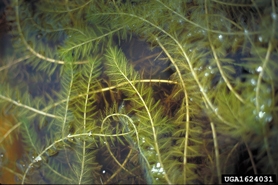Eurasian watermilfoil
(Myriophyllum spicatum)
Eurasian watermilfoil is a submersed, rooted aquatic plant native to Europe, Asia, and northern Africa. It was first reported in the United States in the 1880s and Wisconsin in the 1960s. Eurasian watermilfoil can reproduce via fragmentation, meaning a single stem fragment introduced to a waterbody could take root and establish a new population. Although it is present in almost every county in Wisconsin, it has only been verified in less than 10 percent of waterbodies statewide. While Eurasian watermilfoil can grow to nuisance levels in some waterbodies, recent studies have found that most Wisconsin lakes currently have populations at low frequencies, with relatively few lakes exhibiting very dense growth.
Other names for this plant include:
- Common names: Eurasian watermilfoil, spiked watermilfoil, EWM
- Scientific names: Myriophyllum spicatum var. muricatum
Classification in Wisconsin: Restricted
- Ecological and Socio-economic Impacts
-
- In some waterbodies, Eurasian watermilfoil can form large, floating mats of vegetation on the surface, preventing light penetration for native aquatic plants and causing a navigational impediment.
- Although Eurasian watermilfoil provides some habitat for fish and invertebrates, it gives lesser quality habitat than the native plants it displaces if it grows too high densities and forms a monoculture.
- Identification
-
Leaves: Feather-like and divided into 12 or more pairs of thin leaflets. Leaves are typically arranged around the stem in whorls (groups) of 4.
Flowers: Small, yellow, and four-parted. Flowers are arranged on a short stem above the water's surface.
Stem: Typically 3 to 10 feet long, although it may grow longer in clear water conditions. It can appear brown, green, red, or white.
Similar species: Native milfoil species, such as northern watermilfoil (Myriophyllum sibiricum), various-leaved watermilfoil (Myriophyllum heterophyllum), and whorled watermilfoil (Myriophyllum verticillatum); coontail (Ceratophyllum demersum).
Eurasian watermilfoil can usually be distinguished from their native lookalikes by counting the pairs of leaflets; the leaves on native milfoils have ten or fewer pairs of leaflets, whereas Eurasian watermilfoil leaves typically have 12 or more leaflet pairs. The stems and leaves of Eurasian watermilfoil are generally limp out of the water and will often appear reddish, particularly near the plant tips. In contrast, native milfoils generally have stiffer leaves and stems, typically not reddish. However, Eurasian watermilfoil can hybridize with native northern watermilfoil (i.e., M. spicatum x M. sibiricum), and the hybrids often have characteristics that are indicative of both Eurasian watermilfoil and the native north milfoil (e.g., a combination might have a slightly reddish stem and only 11 leaflet pairs).
- Distribution
-
See the reported locations of Eurasian watermilfoil in Wisconsin.
Do you know of other populations? Please send us a report.
- Control
-
Prevention: The best way to keep a lake free of Eurasian watermilfoil is to prevent its establishment. Wisconsin's invasive species law prohibits the transport of aquatic plants, live animals and water from a waterbody, with some exceptions for bait.
- Before leaving the boat launch, conduct the following actions required by law:
- Inspect and remove aquatic plants and animals from boats and equipment.
- Drain all water from the boat and equipment.
- Before entering another waterbody:
- Spray boat and equipment with high-pressure hot water, or
- Allow the boat and equipment to dry out of water for at least five days.
Chemical: Herbicides that are labeled to control milfoil include 2,4-D, triclopyr, fluridone, endothall, imazamox, flumioxazin, carfentrazone-ethyl, diquat, penoxsulam, and florpyrauxifen-benzyl (commonly known as ProcellaCORTM). Most chemical applications are made in the spring during the early stages of active growth to reduce effects on native plants. However, research has shown that herbicide treatments used to control Eurasian watermilfoil can be more harmful to native plant communities than the presence of Eurasian watermilfoil itself, suggesting that chemical control could do more harm than good unless there is strong evidence of high ecological, social, or economic impact. An approved Chapter NR 107 permit is required to use herbicides in a Wisconsin waterbody to control aquatic plants.
Manual: Mechanical harvesting can provide temporary Eurasian watermilfoil control to help mitigate recreational and navigational impacts. Hand harvesting by snorkelers or divers is more resource-intensive and may only be practical for small populations; however, it can provide more extended control than mechanical harvesting since the entire plant (including roots) is typically removed.
Biological: Milfoil weevils, which are small, native aquatic beetles that feed on Eurasian watermilfoil and native milfoil species, are sometimes used as a biological control mechanism. However, open-field study results on their efficacy are mixed, and none show that milfoil weevil stocking is effective at achieving significant long-term Eurasian watermilfoil control.
Developing an aquatic plant management plan can help assess all available management options and guide decision-making. All control methods can be used alone or in combination as part of an integrated pest management (IPM) strategy.
NOTE: Product names are provided solely for your reference and should not be considered exhaustive or endorsements.
- Before leaving the boat launch, conduct the following actions required by law:
- Resources
-
- The Science Behind the "So-Called" Super Weed
- Long-term Trends in Unmanaged Populations of Eurasian Watermilfoil
- Hybrid Watermilfoil and Herbicide Resistance
- Is the Cure Worse Than the Disease? Comparing the Ecological Effects of Eurasian Watermilfoil and the Herbicide Treatments Used to Control It
- Eurasian Watermilfoil, USGS Nonindigenous Aquatic Species Database



